Research Papers
The ICARE Project: Insights into the Formation and Consolidation of Archaeology in Western France (ca. 1850–1990)
Abstract
Paper
The ICARE Project: Insights into the Formation and Consolidation of Archaeology in Western France (ca. 1850–1990)
Estimated at more than 70,000 images, the documentary archive of the former Laboratoire d’Anthropologie in Rennes, created by Pierre-Roland Giot during the 1950s, includes drawings on various media, photographic negatives on plate glass, films, slides and paper photos, the oldest of which date from the second half of the nineteenth century. These documents are an exceptional source of information for understanding the emergence of prehistory and archaeology in Brittany and, by extension, France. Most of the early documentary material was generated by the Groupe Finistérien d’Études Préhistoriques (GFEP) established at the Musée de Préhistoire de Penmarc’h. P-R. Giot (1919–2002), last surviving member of this group, preserved the GFEP archives and integrated them into the Laboratoire d’Anthropologie. His own research activity during the whole second half of the twentieth century, as well as the contributions of researchers such as J. Briard and J. L’Helgouac’h, led to continual additions of material to the dataset. The ICARE (Iconographie et Collections d’Anthropologie de Rennes) Project aims at analysing, preserving and disseminating this priceless source of information.
Introduction
The Archaeosciences Laboratory (the historical core of the ‘Unité Mixte de Recherche 6566 CReAAH’), which is based at the University of Rennes 1, in France, comprises a wealth of exceptional archived material, including more than 70,000 unpublished documents relating to the archaeological and cultural heritage of Western France (Figure 1). This collection was assembled over the six decades of the unit’s existence, and incorporated material from the former Laboratoire d’Anthropologie in Rennes, founded by archaeologist Pierre-Roland Giot (1919–2002). This iconographic collection, dedicated to French prehistory, is not only of anthropological value, but is also of ethnographic, or even environmental interest, because it contains documents dating back to the nineteenth century, and even to the eighteenth century in some cases. It was enriched throughout the twentieth century by the addition of images on various media: glass plates, photographs, watercolours, drawings on tracing paper, etc.
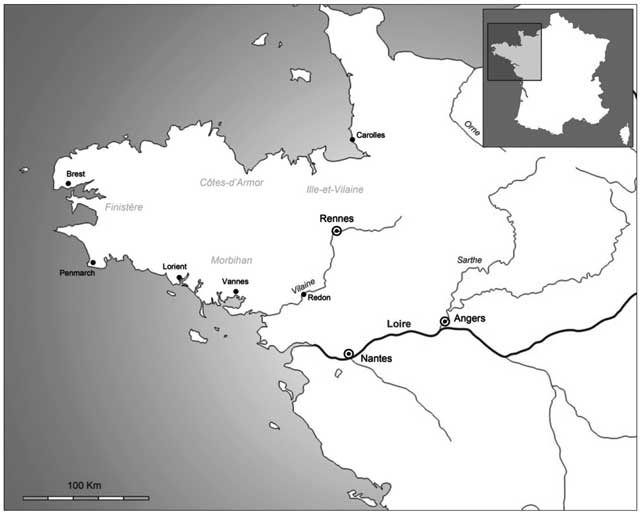
Fig. 1: Map of Western France, showing localities cited in the text (drawn up by the authors after D. Dalet, http://d-maps.com).
In 2007, conscious of the priceless value of these archives, a project work team was established to begin researching and cataloguing these documentary resources, to ensure their conservation and, in the medium term, to make them accessible to the scientific community. The project is not limited to an analysis of the collections from the second half of the nineteenth and early twentieth centuries, but includes documents brought together by earlier generations of researchers, which originated in the collections held by the current Archaeosciences Laboratory as part of the ‘Unité Mixte de Recherche 6566 CReAAH’ (Archaeology, Archaeosciences and History Research Centre, University of Rennes 1). As a result, the slides, films, negatives, paper prints, drawings, maps, etc. are the records of the activities of researchers, such as Pierre-Roland Giot (1919–2002), Jacques Briard (1933–2002) and Jean L’Helgouac’h (1933–2000), between the 1950s and the 1990s. It is important to note that certain documents of this more recent collection are in a far worse state of preservation than some of the older material. This is particularly the case for the slides and films produced by P-R. Giot from 1950 until 1960.
This paper is a brief overview of the nature and extent of the archives, the researchers involved in its compilation, and a progress report on the project. Moreover, the work on the archives is continually evolving, as new elements of it are discovered. For example, recently correspondence and handwritten notes were found inserted as page marks into books that belonged to the researchers involved, each has required analysis and contextual investigation. Due to the enormous number and significance of the preserved documents, this article can only provide a partial account of the extent and potential of the documentary collection.
The Archaeosciences Laboratory Archives in Rennes
The period between ca.1850 and 1939, during which the main core of the early documentary archives was assembled, was a period marked by significant events that effected political, social and scientific life in France.
During this period there were some extraordinary social and political upheavals and conflicts: the 1848 revolution against Louis Philippe, the establishment of the Second Empire in 1851, the Franco-Prussian War and the elimination of the Paris Commune in 1871, the Great War of 1914–1918 and then the onset of World War II. During the same time as these crucial events, the specific discipline of prehistory was founded, and established its scientific bona fides. The contribution of Jacques Boucher de Perthes (1788–1868), recognised in the 1850s by the scientific establishments of both England and France, marked the essential first stage in our knowledge of early human societies.
Scientific activity in the late nineteenth century was organized around two main types of associations: learned societies and scientific congresses. However, awareness of the need to preserve and to record the vestiges of the past really began during the first three decades of the nineteenth century, and was then gradually institutionalised through the publication of scientific journals and, from 1887 onwards, through acts of legislation to regulate ‘the conservation of monuments of art having a historical or artistic interest’ (Hurel, 2007: 96–108). The continuous advances made in the domain of photography in the nineteenth century opened up new possibilities for its potential for recording and providing unique documentary resources for evidence of the past.
Within this general historical context, and during the second half of the nineteenth and the early twentieth centuries, the Rennes Archaeosciences Laboratory archival documentary collection began. In 1921, a group of archaeology enthusiasts, who lived in or spent part of the year in western Brittany, comprising Charles Bénard (1867–1931), Alfred Devoir (1865–1923), Émile Morel (1864–1927), Canon Jean-Marie Abgrall (1846–1926) and Abbé Favret (1875–1950), came together and founded the Société civile du Musée d’Archéologie de Penmarc’h in Finistère (Motet et al., 1929). In 1923, this association became the Groupe Finistérien d’Études Préhistoriques (GFEP; Figure 2).
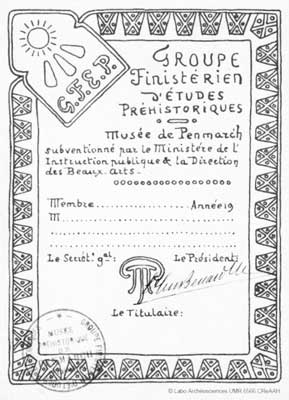
Fig. 2: Membership card of the Groupe Finistérien d’Études Préhistoriques (GFEP). From the 1920s. © Labo Archéosciences UMR 6566 CReAAH.
This group regarded itself as a collaborative movement and distinct from the Société Archéologique du Finistère, that was created in 1845 (Giot, 1972a: 433–497). Even though they were supported by the state, the GFEP relied mainly on private donations. Because of this, the role of Gabrielle Philippson (1880–1941), the daughter of the Belgian banker Franz Philippson and the second wife of Charles Bénard, became particularly important for financing the activities of the group. Very rapidly, the GFEP received national recognition, and from 1926 onwards it became the Institut Finistérien d’Etudes Préhistoriques (Desailly, 1926).
Whether working as individual researchers, or as members of other learned societies, certain members of the GFEP had been actively participating in, and contributing to, archaeology long before the group’s foundation in 1921. Alfred Devoir was the most remarkable example of this kind of researcher (Figure 3). Born in Lorient on June 25, 1865, Devoir began working on the megalithic monuments of the Morbihan region around 1890, and continued his research on the megaliths of Brest (western Finistère, Brittany).

Fig. 3: Alfred Devoir (1865–1926). © Labo Archéosciences UMR 6566 CReAAH.
While he was employed as a Captain and Commander in the French Navy, Devoir also made significant contributions to prehistory. His two main areas of archaeological research, both highly innovative for their time, were the archaeo-astronomical analysis of megalithic monuments and the long-term evolution of the coastline. Regarding the latter, Devoir introduced the concept of ‘kinematics’ for the study of coastal dynamics and sea-level rise. At the beginning of the twentieth century, he published a series of papers on this subject which have become an indispensable reference for regional researchers (Devoir, 1912; 1923). Apart from these publications, his manuscript notes and photographs largely reflect this dual interest in monuments and coastal environment. He not only contributed to the consolidation of prehistory as a research discipline, but he was also a member of several learned societies and participated in various initiatives to conserve and protect local archaeological sites.
In addition to Devoir’s membership of the GFEP, he became vice-president of the Société Archéologique du Finistère. From 1902 to 1913 Devoir was also corresponding member of the sub-commission on Megalithic Monuments, chaired by the geologist and prehistorian Geoffroy d’Ault du Mesnil (see below). Concerned about the future of Brittany’s prehistoric sites, Devoir spent time and money to protect them. He contributed to the inventory of heritage sites in western France, enabling several of them to be classified under the category of Historical Monuments. The paramount example of his commitment is exemplified by Devoir’s purchase, jointly in 1906 with Dr. Mathurin Kermarec (1860–1934; Figure 4) of the gallery grave of Mougau at Commana, in order to preserve it. In 1919, as a result of a mental illness Devoir retired from public life, and he died in Brest in February 1926. He was considered by P-R. Giot as the ‘thinking brain’ of the GFEP (Giot, 1984).
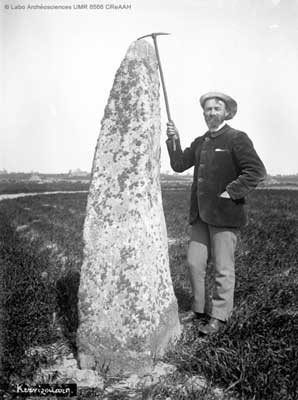
Fig. 4: Dr. Mathurin Kermarec (1860–1934). Photograph by A. Devoir (1865–1926). © Labo Archéosciences UMR 6566 CReAAH.
Another member of the group, Charles Bénard was one of the most controversial personalities involved in prehistory and archaeology in France during the late nineteenth and early twentieth centuries (Figure 5). Born in Redon (Ille-et-Vilaine) on February 14, 1867, Bénard studied in Bordeaux and entered the naval academy. In Bordeaux, he held a series of posts in maritime administration and in 1897 he founded the Société Océanographique du Golfe de Gascogne.

Fig. 5: One of the last images of Charles Bénard (1867–1931), in the centre, during the ‘Cargos du Désert’ expedition in 1931. © Labo Archéosciences UMR 6566 CReAAH.
Bénard published several oceanographic studies (in books and articles) and some papers about the Bordeaux region. He participated in a series of voyages to the Arctic, the first of which was in 1908 on board the ‘Jacques Cartier’. This expedition was sponsored by the Société Océanographique du Golfe de Gascogne, and its main objectives were to explore the island of Novaya-Zemlya, in the Russian Arctic, to analyse its potential as a fishing ground, and to carry out geological research and cartographic surveys. Despite some successful results, the expedition turned into a scandal: Bénard abandoned his ship and crew at Arkhangel’sk, leaving the organizing committee with the task of repatriating the expedition members (Barr, 1987).
After World War I, Bénard travelled a great deal between Paris, Penmarc’h and the Côte d’Azur, and it was from this time onward, that he became more interested in archaeology. In 1919, following the death of Louis Le Pontois (former naval commander and archaeologist in Lorient from 1894; see Banallec, 2004; Langouët et al., 2007a; 2007b), Bénard adopted the name of Bénard-Le Pontois, which he used only within the milieu of archaeology.
In 1929, Charles Bénard published Le Finistère Préhistorique (Bénard, 1929), a book that was the result of a collaboration between several members of the group, but which he finally published as its single author. The book includes a Preface by Dr. Louis Capitan (1854–1929; Figure 6), famous doctor and prehistorian working in Paris (Vaufrey, 1929; Peabody, 1930). As a result of his research in Finistère, but also by taking advantage of his contacts with members of France’s highest society, Bénard succeeded Dr. Capitan, after his death in 1929, as professor of archaeology at the École d’Anthropologie in Paris. In 1931, after returning from a scientific expedition to the Sahara (‘Les cargos du désert’; Bénard, 1931), he suicided, after killing his two children, Jacques and Charlotte, who were aged 12 and 13.
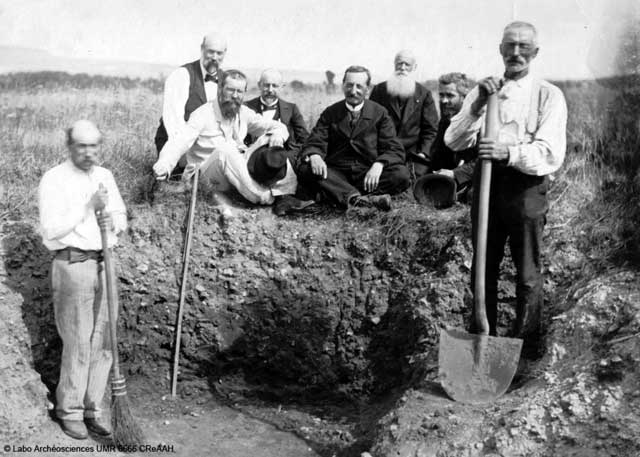
Fig. 6: Excavations of the Campigny site (Blangy-sur-Bresle, Seine-Maritime) on July 25, 1897. Seated on the section in the foreground, on the left, L. Capitan (1854–1929) and, next to him in the centre of the image, G. d’Ault du Mesnil (1842–1921). © Labo Archéosciences UMR 6566 CReAAH.
The lives and contributions of independent scholars such as Devoir and Bénard represent an essential and important part of the archives. The archives comprise material from the interactions between researchers from the GFEP and those not belonging to it. In this way, the preserved archival collection is enriched by certain documents that have resulted from this kind of exchange.
One of the most important examples of this interchange can be found in part of the personal archives of Geoffroy d’Ault du Mesnil (1842–1921; Figure 6). Born in the region of Angers on October 17, 1842, d’Ault du Mesnil became involved with the disciplines of geology and mineralogy, due to the support of the Comte de Limur, a politician linked to South Brittany’s leading scientific society (Société Polymathique du Morbihan). D’Ault du Mesnil soon became a member of a number of important learned societies, his participation coinciding with a great expansion in knowledge about Brittany’s prehistory, and with key research undertaken on important megalithic sites, such as Mané Lud, the Saint-Michel tumulus, Mané er Hroëk and Gavrinis.
In 1875, d’Ault du Mesnil moved to Picardy where his interests then shifted to exploring the artefacts of earliest prehistory. In Abbeville, he was in charge of the reorganization of Boucher de Perthes’ Museum (Cohen and Hublin, 1989) and, as a result of his research in the Somme Valley, he discovered the Quaternary deposits of Champ de Mars at Abbeville (Figure 7). After the death of Gabriel de Mortillet (1821–1898), d’Ault du Mesnil was appointed curator at the École d’Anthropologie in Paris. He was also nominated as President of the Société d’Anthropologie, vice-President of the Association pour l’Enseignement des Sciences Anthropologiques, President of the Commission des Monuments Mégalithiques and President of the Prehistoric Section in the Commission des Monuments Historiques. As member of the École d’Anthropologie, he participated in the 1889 and 1900 Universal Exhibitions in Paris, as an organizer, and displayer of part of his private archaeological collections (Anonymous, 1889; Capitan, 1900; Müller-Scheessel, 2001). From 1900 onwards he actively collaborated with Zacharie Le Rouzic (1864–1939) in the study and restoration of Morbihan’s megalithic monuments. Well known and respected by his contemporaries, d’Ault du Mesnil died in Paris on March 11, 1921 at the age of 78.
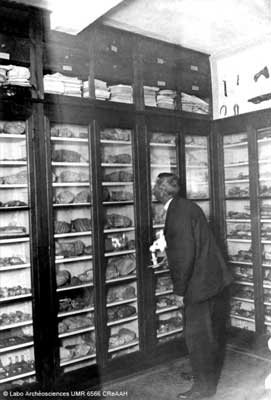
Fig. 7: The prehistoric and geological collections of G. d’Ault du Mesnil (1842–1921) at Abbeville (around 1900–1910). © Labo Archéosciences UMR 6566 CReAAH.
After his death, his widow donated part of his personal archives to Charles Bénard, which included material from d’Ault du Mesnil’s research activities in Brittany from 1900 onwards. This material provides information about the initial training of the young Henri Breuil (1877–1961) (Brodrick, 1963; Hurel, 2011), a great French prehistorian, who remains one of the least understood figures of historiography in France. A very preliminary analysis of d’Ault du Mesnil’s documents, now conserved in Rennes, has been published by López-Romero and Le Gall (2008), while more detailed research on his life and scientific activities is being carried out (López-Romero, in preparation).
The last surviving member of the Institut Finistérien d’Études Préhistoriques, Pierre-Roland Giot (1919–2002), compiled, studied and conserved all of these documents, integrating them into the structure which he set up within the Faculty of Science at Rennes: the Laboratoire d’Anthropologie, Préhistoire, Protohistoire et Quaternaire armoricains (Figure 8).
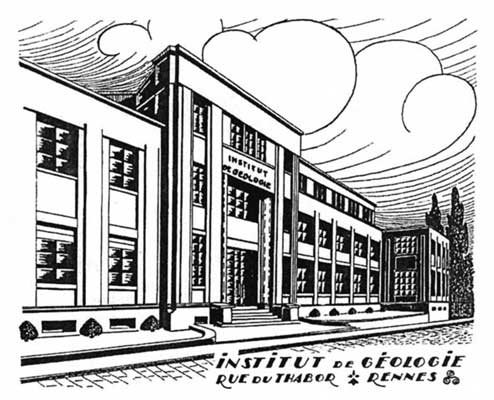
Fig. 8: The Institut de Géologie of the Faculty of Sciences in Rennes, first premises of the Laboratoire d’Anthropologie (drawing by Y. Millon, 1937).
Born on September 23, 1919 in Carolles (Manche, Normandy), Giot became a member of the Institut Finistérien d’Études Préhistoriques in 1937, even though he was only a young student, barely eighteen years old (Giot, 1972b: 549). His interest in prehistory began early as his school holidays past-time was making an inventory of the prehistoric monuments of the area around La Forêt-Fouesnant. Giot’s university studies took him to Paris, then to undertake a science degree in Grenoble, where he carried out its first research work in geology. He later obtained a doctoral thesis in anthropology at Rennes (Giot, 1951). After beginning his career as a researcher at the Centre National de la Recherche Scientifique (CNRS) in 1943, Giot was appointed as the head of the Museum of Penmarc’h in 1947, at the same time as becoming Director of Prehistoric Antiquities for the Western Regional Division of France (Circonscription in French), which then covered seven departments. He held this position until 1972.
During the 1950s, when the Penmarc’h Museum became attached to the Faculty of Science at Rennes University, Giot created the Laboratoire d’Anthropologie, which was formerly part of the Institut de Géologie. Giot recruited collaborators (Figure 9) and equipped the laboratory to develop multi-disciplinary research in biology, anthropology, geology, petrography, chemistry, etc. (Audouze, 2003; Collectif, 1990).
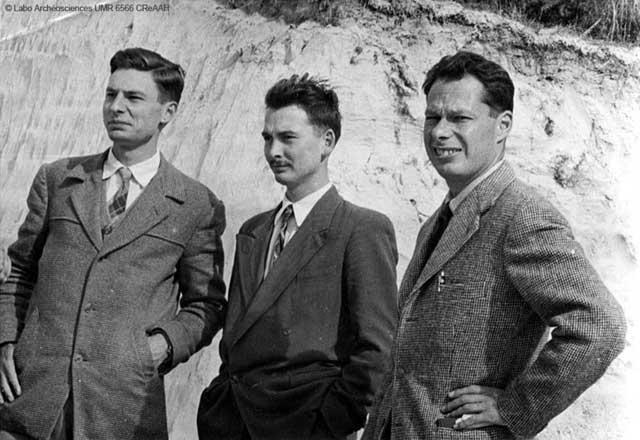
Fig. 9: From right to left, P-R. Giot (1919–2002), J. Briard (1933–2002) and J. L’Helgouac’h (1933–2000). Around 1955. © Labo Archéosciences UMR 6566 CReAAH.
Even if his work remained limited to the Armorican (northern Brittany) context, Giot served on the scientific committee of the Archaeological Research Centre, in the same way as the other directors of the major prehistory laboratories of the time, which included André Leroi-Gourhan at the Sorbonne and the College de France, François Bordes at Bordeaux and Gabriel Camps at Aix-en-Provence (Audouze, 2003: note 28). From the late 1950s until the 1990s, Pierre-Roland Giot exercised administrative and scientific responsibilities, successively and even concurrently as Director of Prehistoric Antiquities for the 4th regional division (Circonscription in French), Chief Curator at the Carnac Museum and, for an even longer period, at the Penmarc’h Museum as well. At the same time he was a researcher with the CNRS, Director of the Laboratoire d’Anthropologie, and later head of a CNRS research team (Equipe de Recherche: ER 27), which then became an internal research unit (Unité Propre de Recherche) of the CNRS (UPR 403), and then a Joint Research Unit (Unité Mixte de Recherche; at first UMR 157, subsequently UMR 6566), which today is known as the Centre for Research in Archaeology, Archaeosciences and History (CReAAH: Centre de Recherche en Archéologie, Archéosciences, Histoire).
Giot’s research on the prehistory and the archaeology of Brittany clearly had an impact on the whole set of documents belonging to the older collection. Throughout his career, Giot used the documents and records of his predecessors, reclassifying them, copying them and reinterpreting the information that they contained. Thus, we find some paper records belonging to Devoir, Bénard, d’Ault de Mesnil and others in the administrative files created by Giot as part of his archaeological inventories of sites at Morbihan, Finistère, Côtes d’Armor and Ille et Vilaine. Although this approach could be regarded from a reductionistic viewpoint as a harmful breaking up of the GFEP documentary collection, we think that, from a historical and archival perspective, this reclassification should be considered as just an additional stage in the complex and dynamic history of the archives of the former Laboratory of Anthropology. This perspective is essential to understanding the spirit of the ICARE Project, which allows us to reconsider the documentary base not only through its isolated components, but also in an organic way. The older collection can be explained in terms of the documentary material from the second half of the twentieth century, while the two complement each other, forming integral parts of a whole that can no longer be split up. It is only by bearing this in mind, and by putting the collection in its context, that we can guarantee its value as a scientific resource for research.
The launching of the ICARE Project represents a true rediscovery of a mainly hidden reality neglected by the majority of archaeologists in the region. The objectives, methodologies and measures to be implemented within this project are presented in the following section.
The ICARE Project: Preservation, Research, Dissemination
The ICARE Project plans to preserve and develop these exceptional documentary collections. The project has three fundamental aspects, linked foremost, to the preservation of the documents, to their study and dissemination, and to their progressive accessibility to the scientific community and, in the long term, to the general public as well.
Preservation
The ICARE Project aims to ensure protection of the media, in particular the photographic glass plates, the oldest parts of this collection, that were not accessible for viewing up until now, with some rare exceptions. Although this precautionary measure could deprive regional, national and international research of an exceptional resource, it ensured the relatively good conservation of the media. However, in spite of all of the precautions taken, certain media have deteriorated with the passage of time (photographic slides, for example).
In this context, the purpose of the ICARE Project is:
- to assess the condition of the media and consider the associated means of protection;
- to ensure their long-lasting conservation;
- to facilitate the utilization of these fragile documents;
- to ensure referencing of these resources to allow their subsequent scientific exploitation.
In this way implementation of the plan for preserving this exceptional iconographic heritage will aim, on the one hand, at the systematic digitalization of the documents and, on the other hand, at the conservation of the original media under optimal conditions, protected from the effects of light, humidity and fire risk. The enormous advantage of new information technologies is that it is now possible to work on these documents without having to handle them which can only contribute to their better conservation1.
The media targeted by this project comprise several different types:
- glass plates (approximately 4,000), which for the most part belong to the collections of Devoir and Bénard;
- photographic slides and negatives (estimated at 40,000), mainly forming part of the collections of Giot, Briard and Monnier;
- paper documents of various formats and nature: plans, sketches, maps, postcards, field surveys, notes, etc. (estimated at 30,000 items), some of them (prints on paper) being associated with the collections of glass plates;
- 16-mm films (approximately 100), mainly produced by Giot during the years 1950–1960, in particular covering scenes of excavation or reports of the ‘ethnographic’ type.
Research
In addition to concerns regarding the preservation of the documentary material, the ICARE Project necessitates collaborative research. The identification of the scenes, monuments and landscapes represented, as well as their localization and crediting of copyright holders for photographs or drawings, are all required to help transform each ‘image’ into a ‘scientific document’ that can be utilized, not only within the framework of a historiographic approach, but also in archaeological research (inventories, summary reviews, etc.). We emphasise that a number of the monuments or landscapes represented have changed, sometimes even completely disappeared, so the old/original image remains the only testimony and material available for study.
The scientific referencing of the iconographic documents relies on collaboration between several researchers working within the scope of the present joint research unit of the CReAAH2, with the objective of publishing a first series of collective studies making use of this documentary base within the framework of the research topics currently developed at CReAAH3.
In fact, several projects in progress are directly associated with the ICARE Project. For example, ICARE was selected as one of the components of the European Project Arch Manche4, which aims to analyse the evolution of the coastal landscape (and the shoreline in particular) on both sides of the English Channel, based on various old iconographic sources.
Drawing its sources from multiple areas of research, the collection is likely to be able to support academic research, and even generate subjects for dissertations or doctoral theses. Thus, the doctoral thesis of F. Cousseau (University of Rennes 1, under the supervision of L. Laporte), is partly based on the use of documents concerning the monuments of Barnenez and Carn Island for the analysis of megalithic architecture and landscapes of Western France. This type of academic research work fulfils the dual role of refitting the scientific context of these sets of monuments, as well as ensuring an aspect of research training in line with the core themes developed within the framework of the CReAAH research unit.
Secondly, the objective is to open up this document collection to a larger audience (an open resource), within a legal and commercial framework that is currently under development. Indeed, as we have already stressed, many documents cover topics other than the archaeology and the prehistory of Western France; historians, geographers and geologists are likely to find these resources useful, in the same way as ethnologists and specialists interested in the history of costumes and seafaring, etc.
Dissemination
The opening-up of this documentary collection to the scientific community, in its numerical/catalogued form, will facilitate broader access to the material and will lead to optimal cross-disciplinary exploitation, in particular in the form of publications, not only in the field of archaeological research, but also in the areas of anthropology, ethnology or the environmental sciences. In addition to the possible uses of this documentation in the field of scientific research, this development also involves the creation of a teaching aid that can be used to provide broader community access to the documentary resources.
As an illustration of the work already completed under the ICARE Project, two aspects are detailed below:
- initially, scientific publications relating to studies undertaken by the research team in the framework of projects concerning site monographs (Daire and Lefeuvre, 2001) and regional inventories (Sparfel and Pailler, 2009), or even from the point of view of historiographers illustrating the history of science (López-Romero, in preparation);
- secondly, various presentations have allowed us to report on the progress of this project (Daire and López-Romero, 2011; 2012). Among these initiatives, the most important development arising from the ICARE Project is the exhibition Au fil de l’eau (1851–1939), le littoral et son étude à travers les archives de l’ancien Laboratoire d’Anthropologie de Rennes [At the Water’s Edge: coastal areas and their study as seen through the archives of the former Laboratoire d’Anthropologie of Rennes], which was undertaken in 2011 (Figure 10).
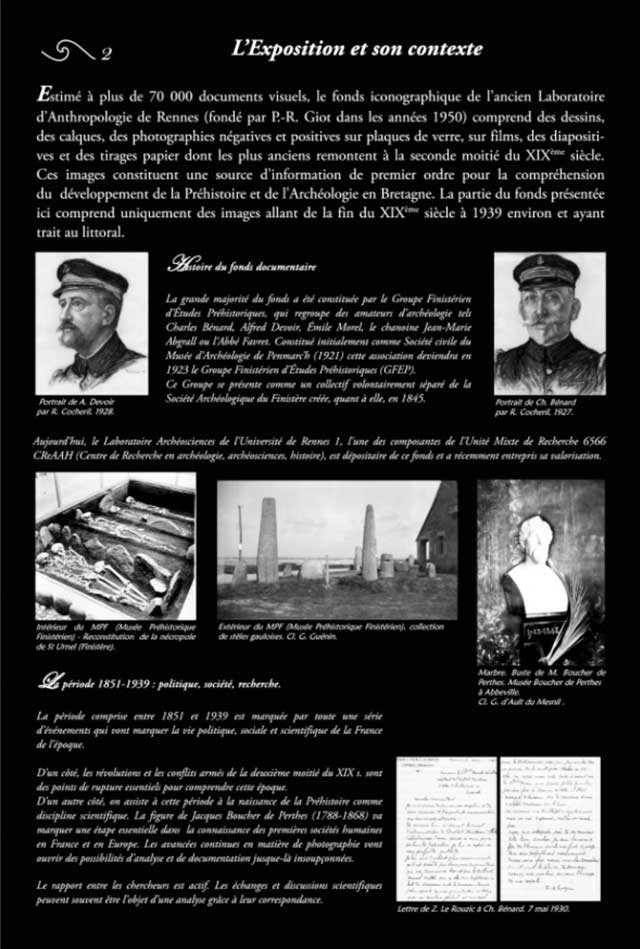
Fig. 10: Panel no. 2 of the exhibition: Au Fil de l’eau (1851–1939), Le littoral et son étude à travers les archives de l’ancien Laboratoire d’Anthropologie de Rennes.
The exhibition Au fil de l’eau ... aims at illustrating the continuity between pioneering work in archaeology and the approaches adopted by present-day researchers. It is based on a small selection of iconographic documents from the archives, and focuses on the special geographic setting of Brittany, comprised of islands and coasts.
The exhibition is organised around six main themes:
- The research potential of coastal sites (intertidal, coastal and underwater) and dedicated fieldwork methods;
- Erosion and evolution of the coasts;
- Seafaring, maritime traffic and port installations;
- People of the shore, peoples of the sea: identity, space and territory;
- Exploitation of coastal and marine resources: acquisition, distribution, consumption and transformation;
- Geology and environmental studies of maritime and coastal landscapes.
The exhibition is supplemented by an introduction to the historical context as well as brief biographies of the main authors of the images.
Designed as a mobile exhibition comprising 20 ‘roll-up’ panels, it was first mounted in 2011 at the Palais des Arts et des Congrès in Vannes (Morbihan)5, 6. Subsequently, it went on tour in 2012 within the University of Rennes 1, first at the Beaulieu Campus and then at the Penmarc’h Museum of Prehistory at Saint-Guénolé (Finistère), which meant a veritable return to its origins, in view of the history of development of the documentary base. At the same time an online exhibition of Au Fil de l’eau ... was produced on an experimental basis within the framework of the multimedia library of the University of Rennes 1, which represents a first step towards opening up the archive’s information to the general public, since access to this exhibition is free and online7.
Conclusion
Primarily unpublished, the archives of the former Laboratoire d’Anthropologie in Rennes provide us with an extremely varied and rich picture of archaeology undertaken in this part of France during the period 1850 to 1990. The building up of the archival materials reflects a parallel evolution: the career of each of the researchers involved in its compilation, as well as the history of its reinterpretation and rearrangements over the years. This double history should not only help us pick out particular landmarks on certain sites or landscapes, but also, more fundamentally, it should allow us to trace the general steps in the development and consolidation of research in archaeology and prehistory in Western France. Owing to this record extending back over nearly one hundred and fifty years, the Archaeosciences Laboratory of the University of Rennes 1 Joint Research Unit is not only significant at a national level, but also internationally. Through the preservation, research and communication of archives, the ICARE Project is making it possible to attain our objectives and manage this documentary heritage.
Acknowledgements
The authors wish to thank the CReAAH Joint Research Unit, in particular D. Marguerie and the CIRM (Centre d’Ingénierie et de Resources Multimédia, University of Rennes 1), and also Romuald Lorthioir, for supporting the ICARE Project and for providing human and material resources. The digitizing and processing of archives were performed by Michel Lautram (CIRM), Laurent Quesnel, Francis Bertin and C. Le Gall (CReAAH).
Notes
1 The preservation and digitizing of 16-mm films from the 1950s and 1960s was funded by ATLA (Association des Travaux du Laboratoire d’Anthropologie de Rennes).
2 The scientific referencing of iconographic documents is the result of collective work carried out on a database managed by the Mobydoc software (used by Musées de France to host their collections).
3 See areas of research of the CReAAH on http://www.creaah.univ-rennes1.fr/spip.php?rubrique7.
4 Arch Manche: Archaeology, art and coastal heritage – tools to support coastal management and climate change planning across the Channel Regional Sea. Principal investigator: Garry Momber (Hampshire & Wight Trust for Maritime Archaeology). http://www.hwtma.org.uk/arch-manche. Supported by Europe (FEDER, European Regional Development Fund, Interreg IVa 2 Seas programme).
5 The physical implementation of the exhibition ‘Au fil de l’eau ...’ was funded by the Association Manche-Atlantique pour la recherche Archéologique sur les îles (AMARAI).
6 The exhibition ‘Au fil de l’eau ...’ was mounted for the first time in 2011 at the Palais des Arts et des Congrès in Vannes (Morbihan), during the Homer 2011 international symposium ‘Ancient maritime communities and the relationship between people and environment along the European Atlantic coasts’ (http://homer2011.univ-rennes1.fr/index.php).
7 The online exhibition was produced by the CIRM (Centre d’Ingénierie et de Ressources Multimédia, University of Rennes 1) and designed by J. C. Subilé and S. Proust; free online access on http://icare.univ-rennes1.fr/.
References
Anonymous 1889 La Société, l’École et le Laboratoire d’Anthropologie de Paris à l’Exposition Universelle de 1889. Paris: Imprimeries Réunies.
Audouze, F 2003 La préhistoire et le CNRS. La revue pour l’histoire du CNRS 8, 17 p. http://histoire-cnrs.revues.org/551#text.
Banallec, Y 2004 Essai de biographie de Louis Le Pontois, officier de marine et archéologue. Les Cahiers du Pays de Ploemeur 14: 23–29.
Barr, W 1987 Charles Bénard’s first expedition to Novaya Zemlya, 1908. Polar Record 23: 511–529. DOI: http://dx.doi.org/10.1017/S0032247400008032.
Bénard, C 1929 Le Finistère préhistorique. Publications de l’Institut International d’Anthropologie 3. 337 p. Paris: Emile Noury.
Bénard, C 1931 La mission transsaharienne des ‘Cargos du désert’. l’Illustration CLXXIX, 2 mai-29 août 1931.
Brodrick, A H 1963 Father of Prehistory. The Abbé Henri Breuil: His Life and Times. New York: William Morrow & Co.
Capitan, L 1900 Exposition de la Société d’Anthropologie de Paris à l’Exposition Universelle de 1900. Rapport au nom de la Commission. Bulletin de la Société d’Anthropologie de Paris, V° Série, 1: 105–109.
Cohen, C and Hublin, J J 1989 Boucher de Perthes, 1788–1868: Les origines romantiques de la Préhistoire. Paris: Belin.
Collectif 1990 Pierre-Rolland Giot. In La Bretagne et l’Europe préhistoriques. Mémoire en hommage à Pierre-Rolland Giot. Revue Archéologique de l’Ouest suppl. 2: 5–9.
Daire, M-Y and Lefeuvre, J-Y 2001 L’île Melon, hier et aujourd’hui (commune de Porspoder, Finistère). Bulletin de l’AMARAI 14: 67–92.
Daire, M-Y and López-Romero, E 2011 Au fil de l’eau ... Le littoral et son étude à travers les archives de l’ancien Laboratoire d’Anthropologie de Rennes. Exhibition brochure. 26 p. Rennes: UMR CReAAH.
Daire, M-Y and López-Romero, E 2012 Le projet ICARE et l’exposition ‘Au fil de l’eau ...’. Journée Archéologie, Archéosciences, Histoire, Rennes 24/03/2012, Abstract book, Université de Rennes 1: 35–36.
Desailly, M 1926 Séance du 23 décembre 1926. Bulletin de la Société préhistorique française 23 (12): 300. http://www.persee.fr/web/revues/home/prescript/article/bspf_0249-7638_1926_num_23_12_5960.
Devoir, A 1912 Témoins mégalithiques des variations des lignes des rivages armoricains. Bulletin de la Société Archéologique du Finistère 39: 220–239.
Devoir, A 1923 Un épisode de la submersion des rivages bretons: le pont Crac’h et les vestiges préhistoriques aux abords du Ras Aberwrach. Bulletin de la Société géographique et minéralogique de Bretagne 4: 150–176.
Giot, P-R 1951 (1950) Armoricains et bretons, étude anthropologique. Thèse de Sciences, Rennes. Publ. Travaux du Laboratoire d’Anthropologie de la Faculté des Sciences de Rennes, Mémoires de la Société Géologique et minière de Bretagne 10, 160 p., 36 fig.
Giot, P-R 1972a Historique de la Société. Bulletin de la Société Archéologique du Finistère 99 (2): 433–497.
Giot, P-R 1972b La préhistoire finistérienne, du romantisme à la science contemporaine. Bulletin de la Société Archéologique du Finistère 99 (2): 543–555.
Giot, P-R 1984 Un préhistorien méconnu: Alfred Devoir. Bulletin de la Société Archéologique du Finistère 113: 10–12.
Hurel, A 2007 La France préhistorienne de 1789 à 1941. Paris: CNRS Éditions.
Hurel, A 2011 L’abbé Breuil. Un préhistorien dans le siècle. Paris: CNRS Éditions.
Langouët, L, Gouézin, P, Bihan, S and López-Romero, E 2007a Louis le Pontois et les monuments disparus ou détériorés de la région de Lorient. Les Dossiers du CeRAA 35: 5–29.
Langouët, L, Bihan, S, Gouézin, P and López-Romero, E 2007b Louis Le Pontois et les monuments mégalithiques de l’Île de Groix. Bulletin de l’AMARAI 20: 5–30.
López-Romero, E and Le Gall, C 2008 Le fonds documentaire de Geoffroy D’Ault du Mesnil (1842–1921) et la recherche préhistorique en France. Les Dossiers du CeRAA 36: 65–72.
López-Romero, E (in preparation) Rediscovering Geoffroy d’Ault du Mesnil (I): 1842–1898.
Motet, C, Capitan, L and Bénard, C 1929 Le Musée Préhistorique de Penmarc’h. L’Illustration Économique et Financière, Supplément au nº du 9 mars 1929: 67–72.
Müller-Scheessel, N 2001 Fair Prehistory: Archaeological Exhibits at French Expositions Universelles. Antiquity 75: 391–401.
Sparfel, Y and Pailler, Y (dir.) 2009 Les mégalithes de l’arrondissement de Brest. Coll. Patrimoine Archéologique de Bretagne, co-éd. 290 p. Rennes: CeRAA (Centre Régional d’Archéologie d’Alet) et ICB (Institut Culturel de Bretagne).
Peabody, C 1930 Dr. Louis Capitan. American Anthropologist 32: 567–568. DOI: http://dx.doi.org/10.1525/aa.1930.32.3.02a00280.
Vaufrey, R 1929 Nécrologie. Le docteur Louis Capitan. L’Anthropologie 39: 349–352.


